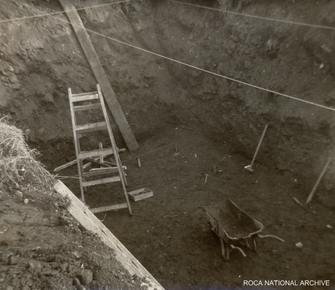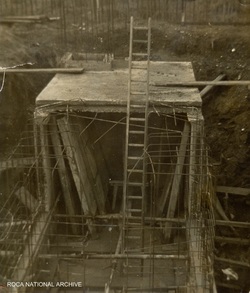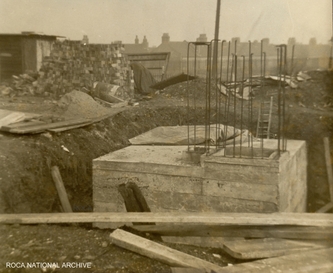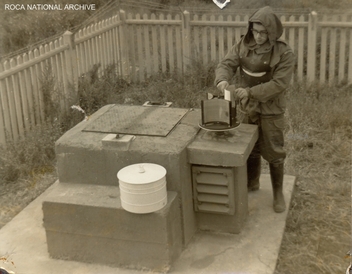UNDERGROUND PROTECTED MONITORING POST
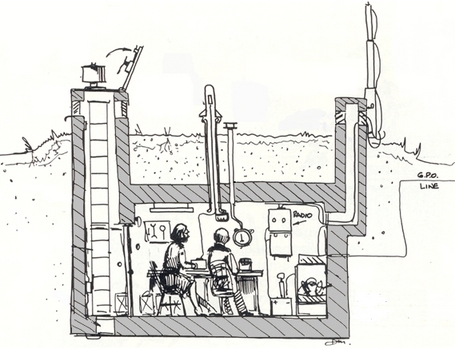
Sketch drawing of the cross-section of the ROC Monitoring Post
“Going Underground”
The added responsibility of reporting nuclear bursts and monitoring fallout and the minimal level of protection from a nuclear bomb meant that such tasks could not be achieved within the current overground Monitoring Posts. These posts were simply not set up to provide any degree of protection from a nuclear explosion.
A decision was therefore taken to trial a prototype "protected" underground post at Farnham, Surrey. The post was constructed in 1956 and on 29/30 September of that year a trial was conducted to ascertain the usefulness of the underground posts. Of the two crews of four personnel engaged in staffing the post during this trial, the second group of four, two ROC and two Home Office Scientific Advisory Branch, were sealed inside with rations, bedding and barracks equipment.
With a few minor changes; mainly to the hatch and air ventilation louvres, the prototype post was deemed effective for the monitoring task of the ROC. The protection provided by the concrete roof and compacted earth mounded above the post was estimated to reduce any external nuclear radiation by a factor of 1,500:1.
After the successful trial of the prototype post at Farnham, a network of approximately 1,563 underground posts were constructed over the next 3 to 4 years. The works were overseen by the Air Ministry Works Department and the ROC and undertaken by local contrractors. The locations of these underground posts were usually adjacent to existing overground aircraft observeration posts and were located in the network within approximately 7 to 10 miles apart from neighbouring posts, although some had to be sited some distance away in order to provide effective underground monitoring capabilities.
Once a site was chosen (usually the site of an aircraft observation post) a hole approximately 9 feet deep was excavated. Within this hole a monocoque structure was cast using re-enforced concrete with a floor approximately 30cm thick, walls approximately 17cm thick and a roof approximately 20cm thick. The whole structure was then bitumen 'tanked' for waterproofing purposes. Soil was compacted over the structure to form a mound leaving the access shaft, doubling as an airshaft, protruding above ground. At the opposite end of the building a further air shaft was formed. Two metal pipes, one 5 inches in diameter and one 1 inch in diameter protruded from the roof and above the four-foot mound to be used with operational instruments. The air vents were covered by downward-sloping louvres above ground and sliding metal shutters below ground to control air flow during contamination by radioactive fallout. Internaly the underground posts were 4.75 metres in length and 2.25 metres in width and height with power being supplied from 12 volt batteries inside the post and a petrol generator used to charge the batteries sited outside the post.
It was necessary for these posts (as well as centres) to be occupied for at least seven days and possibly even up to two weeks or greater after any nuclear event depending upon the situation. Conditions in these posts were cramped and cold and in some damp; although many of these worst ones were abandoned, and it was fortunate for observers that long occupation was never necessary, in practise. Later posts were insulated with polystyrene tiles on walls and ceiling and had rubber matting cut from National Coal Board underground conveyor belts on the floors to provide insulation from the cold.
The creation of the Stratford / East Ham underground ROC monitoring post.
Image Source: Top - ROC Journal / Bottom 4 - ROCA National Archive
